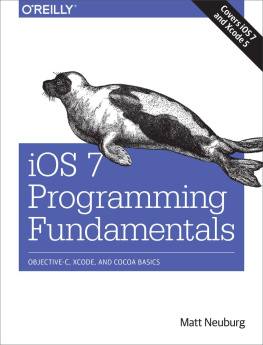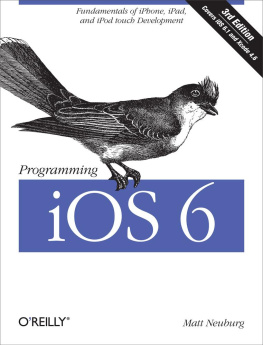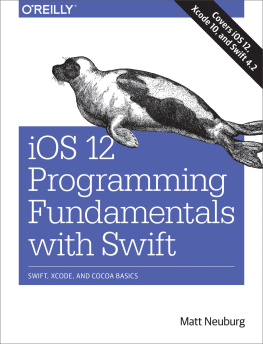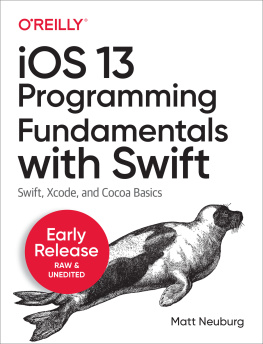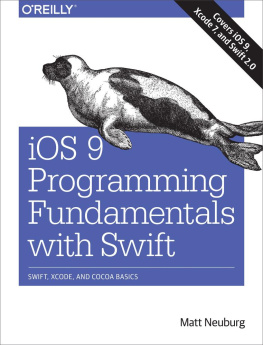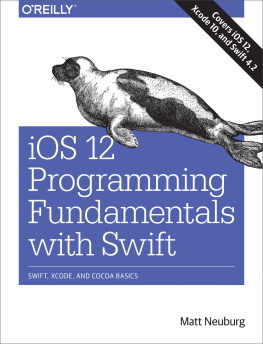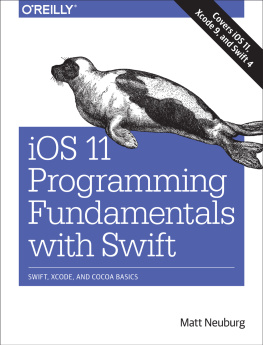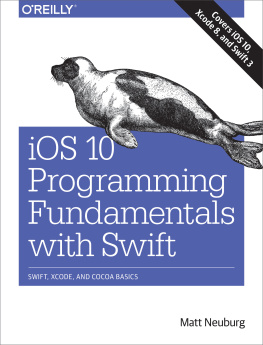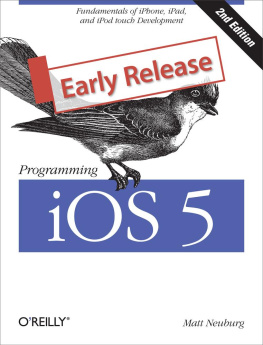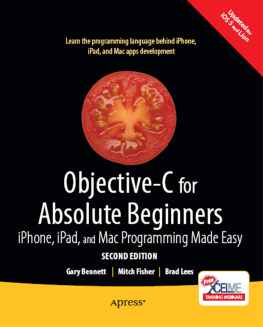iOS 7 Programming Fundamentals
Objective-C, Xcode, and Cocoa Basics
Matt Neuburg
Beijing Cambridge Farnham Kln Sebastopol Tokyo
Special Upgrade Offer
If you purchased this ebook directly from oreilly.com, you have the following benefits:
DRM-free ebooksuse your ebooks across devices without restrictions or limitations
Multiple formatsuse on your laptop, tablet, or phone
Lifetime access, with free updates
Dropbox syncingyour files, anywhere
If you purchased this ebook from another retailer, you can upgrade your ebook to take advantage of all these benefits for just $4.99. to access your ebook upgrade.
Please note that upgrade offers are not available from sample content.
Preface
After three editions of my book on programming iOS Programming iOS 4 (May 2011), Programming iOS 5 (March 2012), and Programming iOS 6 (March 2013) it is as if a friendly but powerful giant had ripped the book in two, just after the end of Part III (Chapter 13). There are now two books:
- This book, iOS 7 Programming Fundamentals , comprising chapters 113 of the earlier books.
- The other book, Programming iOS 7 , comprising chapters 1440 of the earlier books.
The giant was friendly, because it was high time. Programming iOS 6 had grown to an unwieldy and forbidding 1150 pages. In fact, I had been begging for this giant even before Programming iOS 4 was published indeed, before it was even conceived of. My original proposal to OReilly Media, back in early 2010, had been for a book to be called Fundamentals of Cocoa Programming , intended to cover very much the same material as the present book, iOS 7 Programming Fundamentals . But the proposal was accepted only on condition that it be extended to cover much more of Cocoa Touch (iOS) programming; so I complied and set to work on this longer project, and later, despite my impassioned pleas in the autumn of 2010, I was unable to persuade the publisher to break up the lengthy manuscript into two: by that time, all the kings horses and all the kings men could no longer crack Humpty Dumpty apart.
The new situation, therefore, is just what I always wanted in the first place but not quite, because what I most desired was a single book in two volumes. My idea was that the books would have the same title, distinguished as Volume I and Volume II, with successive numbering of pages and chapters: if Volume I ended, say, with Chapter 13 and page 400, then Volume II would start with Chapter 14 and page 401. To this delightfully Victorian extreme, Im sorry to say, OReilly Media were implacably opposed.
Thus, Programming iOS 7 , though it starts with its own Chapter 1 and page 1, nevertheless still picks up exactly where iOS 7 Programming Fundamentals leaves off. They complement and supplement one another. Those who desire a complete grounding in the knowledge needed to begin writing iOS apps with a solid and rigorous understanding of what they are doing and where they are heading will, I hope, obtain both books. At the same time, the two-book architecture should, I believe, render the size and scope of each book individually more acceptable and attractive to more readers.
Those who feel that they know already all there is to know about C, Objective-C, Xcode, and the linguistic and architectural basis of the Cocoa framework, or who are content to pick up such underpinnings as they go along, need no longer (as some in the past have done) complain that the book is occupied with 13 preliminary chapters before the reader starts really writing any significant iOS code, because those 13 chapters have now been abstracted into a separate volume, iOS 7 Programming Fundamentals , and the other book, Programming iOS 7 , now begins, like Homers Iliad , in the middle of the story, with the reader jumping with all four feet into views and view controllers, and with a knowledge of the language and the Xcode IDE already presupposed. And if such a reader subsequently changes his or her mind and decides that a thorough grounding in those underpinnings might in fact be desirable, iOS 7 Programming Fundamentals will still be available and awaiting study.
As for this book, iOS 7 Programming Fundamentals itself, it is the prodigal child, the book I originally wanted to write but which was then subsumed during three editions into the larger world of Programming iOS 4 , Programming iOS 5 , and Programming iOS 6 . Now it is home again, where it belongs, in a volume of its own. Its three parts teach the underlying basis of all iOS programming:
- introduces the Objective-C language, starting with C (which constitutes much more of practical Objective-C than many beginners realize) and then building up to the object-oriented concepts and mechanics of classes and instances.
- takes a break from language and turns to Xcode, the world in which all iOS programming ultimately takes place. It explains what an Xcode project is and how it is transformed into an app, and how to work comfortably and nimbly with Xcode to consult the documentation and to write, navigate, and debug code, as well as how to bring your app through the subsequent stages of running on a device and submission to the App Store. There is also a very important chapter on nibs and the nib editor (Interface Builder), including outlets and actions as well as the mechanics of nib loading; however, such specialized topics as autolayout constraints in the nib are postponed to the other book.
- returns to Objective-C, this time from the point of view of the Cocoa Touch framework. Cocoa provides important foundational classes and adds linguistic and architectural devices such as categories, protocols, delegation, and notifications, as well as the pervasive responsibilities of memory management. Keyvalue coding and keyvalue observing are also discussed here.
The reader of this book will thus get a thorough grounding in the fundamental knowledge and techniques that any good iOS programmer needs. The book itself doesnt show how to write any particularly interesting iOS apps (though it is backed by dozens of example projects that you can download from my GitHub site, http://github.com/mattneub/Programming-iOS-Book-Examples), but it does constantly use my own real apps and real programming situations to illustrate and motivate its explanations. And then youll be ready for Programming iOS 7 , of course!
Versions
This book is geared to iOS 7 and Xcode 5. In general, only very minimal attention is given to earlier versions of iOS and Xcode. It is not my intention to embrace in this book any detailed knowledge about earlier versions of the software, which is, after all, readily and compendiously available in my earlier books. There are, nevertheless, a few words of advice about backwards compatibility, and now and then I will call out a particularly noteworthy change from earlier versions. For example, it has been hard to refrain from pointing out the confusing accretions of interface and terminology caused by the changes in how the status bar works and in the sizes of icons and launch images.
Xcode 5 no longer offers the user, creating a new app project from one of the project templates, an option as to whether or not to use Automatic Reference Counting (ARC), the compiler-based manual memory management technology that has made life so much easier for iOS programmers in recent years. where I still explain what ARC does by describing what you would have to do if you werent using it.

